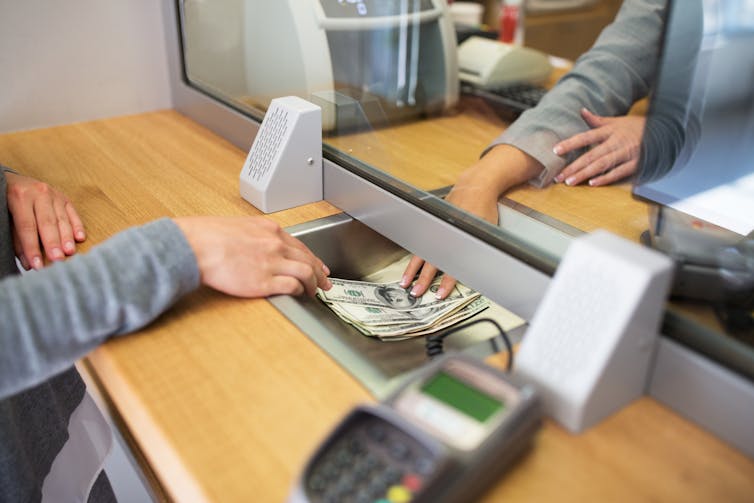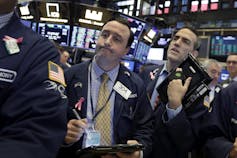How banks have set a trap for the U.S. Fed by creating money: U of T expert

Published: August 29, 2018
The 10-year anniversary of the 2008 financial crisis is upon us.
A decade ago, former U.S. president George W. Bush signed into law the called the Troubled Asset Relief Program (TARP), aimed at purchasing toxic assets and equity from financial institutions to strengthen the country’s shell-shocked financial sector amid the sub-prime mortgage crisis.

How do banks, treasury departments and central banks create money anyway? And does it work to buoy economies teetering on the brink of collapse?
In the U.S., banks are required to set aside, , up to 10 per cent of their deposits to be held at the Federal Reserve.
Here’s how the reserve system works. Let’s say you deposit $10,000 at Bank A. The bank sets aside $1,000 as reserve. It will loan out the remaining $9,000 and charge interest, enabling it to make interest payments to depositors and earn interest income. So Bank A becomes a financial intermediary between savers and borrowers, and money keeps getting created.
How? Because there are many banks in the financial system, and they are required to hold only a fraction (10 per cent) of their deposits. Loans end up deposited in other banks, which increases reserves, deposits – and the money supply.
Money multiplies
In the U.S., the Treasury Department can sell to the open market in order to finance government deficits instead of raising taxes. itself, domestic and foreign banks and investors, and foreign governments will buy and pay for them with American dollars. When the government spends these dollars, they get channelled into the commercial banking system as deposits.
Big and can also sell their own bonds. Today, U.S. stand at $4.8 trillion. And so the system’s money multiplier gets even larger.
When the Fed buys financial assets from financial institutions, it pays for them by making bookkeeping entries into their reserve accounts. Banks can create up to $10 in new loans for every one dollar increase in the commercial banks’ reserves.
During the financial crisis of 2007-2008, the Fed engineered what’s called quantitative easing, or QE, by buying many billions of bad assets from endangered banks.
The banks’ damaged assets became safe because the Fed had bought them. And it also allowed banks to extend more credits to, supposedly, stimulate the economy.
This financial injection multiplied, and money flooded the system.
Here’s how and why.
Bank assets versus liabilities
Mortgage loans are bank assets because banks can call in the loans and the borrower must pay. Deposits, on the other hand, are bank liabilities because customers can withdraw their money at any time, so banks owe that money to them.
If people start defaulting on their mortgage payments and house prices plummet, it can create fears among depositors; they will rush to take their money out of the bank before it collapses and they lose their savings. So in 2008, the Fed stepped in to nip this fear in the bud to prevent a possible system-wide bank run leading to the collapse of banks.

Today, the cumulative balance of over a 10-year period from 2008 to 2018 has risen to $4.3 trillion from $872 billion, an increase of about 400 per cent. Money keeps multiplying.
Why? Recall that each time the Fed buys financial assets from banks, it pays for them by making bookkeeping entries to banks’ reserve accounts, and for every one dollar increase in their reserve accounts, banks can lend out up to $10.
Where has all the money gone?
The financial system is therefore awash with money. That’s why interest rates have been so low for so long. Interest rates, essentially, are the price of money. When the Fed makes it easy for banks to create money, banks must lower the price of money in order to move it into the hands of borrowers. Banks, after all, are in the business of making money by selling money.
And this does not even include . These are U.S. dollar-denominated deposits at foreign banks or at American bank branches abroad, the amounts of which are hard to estimate. And they are not subject to the Fed’s regulations on required reserves. The world is simply flooded with American dollars, with , , and all operating under similar QE policy.

Within the U.S. and major developed and developing economies, part of this flood of cheap money has created significant increases in the world’s and in . By 2017, largest stock exchanges in the world have a market capitalization ranging from US$1.2 trillion to $19 trillion.
Key lesson: The Fed can create money, but it’s hard to predict where that money will go.
Why scant inflation?
Over the period of 2008 to 2018, the U.S. economy has not experienced noticeable inflation, despite the flood of money into the system. The shows it’s increasing at about 1.55 per cent a year. America does not have a problem of too much money chasing too few goods, because there is plenty of money around for imports. That’s where trade deficits came from.
Meantime, while American after-tax have grown at a compounded rate of 6.44 per cent per year, before tax and before inflation is 2.29 per cent per year, which is practically zero in real terms.
The gigantic money-printing scheme, therefore, appears to have benefited banks, corporations and those who can afford to play in real estate markets, in stock markets and in the broader financial world. Broad-based , however, remains unimpressive compared to pre-2008 periods.
The Fed is trapped
The Fed has increased its own over the past couple of years from zero to 1.91 per cent to spur rate hikes in the financial sector. This is the rate that short-term commercial interest rates are pegged to. And it has also started to some of its assets back to the market. When it sells assets, the multiplier works in reverse, resulting in less money available and higher interest rates.
The rationale for this strategy is that the real economy seems to have picked up some momentum as are down and is ticking up. The QE money that has been circulating on and on within the financial and real estate sectors may finally be going somewhere in real sectors.
But facing a total government debt of and climbing, the Fed is trapped – higher interest rates mean bigger interest payments on government debt.
The Congressional Budget Office (CBO) has projected that the government’s net interest costs alone over the next 10 years, rising to be the third largest expenditure item after Social Security and Medicare.
U.S. President Donald Trump’s tax cuts may produce some economic growth, but at the expense of even bigger budget deficits, $1 trillion annually by 2020. That’s two years ahead of CBO’s previous projection.
Ending easy money is not easy
While the Fed has pushed interest rates up, rates in the and in remain at or below zero, and QE is still ongoing there. More money will flow into the U.S. to earn higher rates. Adding to the ongoing trade wars, this global uncertainty will, paradoxically, result in higher demand for the dollar. The will make American exports more expensive and reduce the effects of tariffs on imports.
A silver bullet has yet to be found to break through this vicious circle of debt, the dollar and trade deficit. But interest rates will have to rise to their soon or pension funds will come under enormous stress to hit the eight per cent in order to meet their obligations.
This is going to be a test case of the Fed’s independence.![]()
is an instructor of business management at the .
This article was originally published on . Read the .



